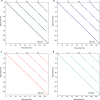Discovery of 33mer in chromosome 21 - the largest alpha satellite higher order repeat unit among all human somatic chromosomes
- PMID: 31477765
- PMCID: PMC6718397
- DOI: 10.1038/s41598-019-49022-2
Discovery of 33mer in chromosome 21 - the largest alpha satellite higher order repeat unit among all human somatic chromosomes
Abstract
The centromere is important for segregation of chromosomes during cell division in eukaryotes. Its destabilization results in chromosomal missegregation, aneuploidy, hallmarks of cancers and birth defects. In primate genomes centromeres contain tandem repeats of ~171 bp alpha satellite DNA, commonly organized into higher order repeats (HORs). In spite of crucial importance, satellites have been understudied because of gaps in sequencing - genomic "black holes". Bioinformatical studies of genomic sequences open possibilities to revolutionize understanding of repetitive DNA datasets. Here, using robust (Global Repeat Map) algorithm we identified in hg38 sequence of human chromosome 21 complete ensemble of alpha satellite HORs with six long repeat units (≥20 mers), five of them novel. Novel 33mer HOR has the longest HOR unit identified so far among all somatic chromosomes and novel 23mer reverse HOR is distant far from the centromere. Also, we discovered that for hg38 assembly the 33mer sequences in chromosomes 21, 13, 14, and 22 are 100% identical but nearby gaps are present; that seems to require an additional more precise sequencing. Chromosome 21 is of significant interest for deciphering the molecular base of Down syndrome and of aneuploidies in general. Since the chromosome identifier probes are largely based on the detection of higher order alpha satellite repeats, distinctions between alpha satellite HORs in chromosomes 21 and 13 here identified might lead to a unique chromosome 21 probe in molecular cytogenetics, which would find utility in diagnostics. It is expected that its complete sequence analysis will have profound implications for understanding pathogenesis of diseases and development of new therapeutic approaches.
Conflict of interest statement
The authors declare no competing interests.
Figures




Similar articles
-
Novel Concept of Alpha Satellite Cascading Higher-Order Repeats (HORs) and Precise Identification of 15mer and 20mer Cascading HORs in Complete T2T-CHM13 Assembly of Human Chromosome 15.Int J Mol Sci. 2024 Apr 16;25(8):4395. doi: 10.3390/ijms25084395. Int J Mol Sci. 2024. PMID: 38673983 Free PMC article.
-
Precise Identification of Higher-Order Repeats (HORs) in T2T-CHM13 Assembly of Human Chromosome 21-Novel 52mer HOR and Failures of Hg38 Assembly.Genes (Basel). 2025 Jul 27;16(8):885. doi: 10.3390/genes16080885. Genes (Basel). 2025. PMID: 40869933 Free PMC article.
-
Global Repeat Map (GRM): Advantageous Method for Discovery of Largest Higher-Order Repeats (HORs) in Neuroblastoma Breakpoint Family (NBPF) Genes, in Hornerin Exon and in Chromosome 21 Centromere.Prog Mol Subcell Biol. 2021;60:203-234. doi: 10.1007/978-3-030-74889-0_8. Prog Mol Subcell Biol. 2021. PMID: 34386877
-
Key-string algorithm--novel approach to computational analysis of repetitive sequences in human centromeric DNA.Croat Med J. 2003 Aug;44(4):386-406. Croat Med J. 2003. PMID: 12950141 Review.
-
Dark Matter of Primate Genomes: Satellite DNA Repeats and Their Evolutionary Dynamics.Cells. 2020 Dec 18;9(12):2714. doi: 10.3390/cells9122714. Cells. 2020. PMID: 33352976 Free PMC article. Review.
Cited by
-
Precise identification of cascading alpha satellite higher order repeats in T2T-CHM13 assembly of human chromosome 3.Croat Med J. 2024 Jun 13;65(3):209-219. doi: 10.3325/cmj.2024.65.209. Croat Med J. 2024. PMID: 38868967 Free PMC article.
-
Tandemly repeated NBPF HOR copies (Olduvai triplets): Possible impact on human brain evolution.Life Sci Alliance. 2022 Oct 19;6(1):e202101306. doi: 10.26508/lsa.202101306. Print 2023 Jan. Life Sci Alliance. 2022. PMID: 36261226 Free PMC article.
-
Novel Concept of Alpha Satellite Cascading Higher-Order Repeats (HORs) and Precise Identification of 15mer and 20mer Cascading HORs in Complete T2T-CHM13 Assembly of Human Chromosome 15.Int J Mol Sci. 2024 Apr 16;25(8):4395. doi: 10.3390/ijms25084395. Int J Mol Sci. 2024. PMID: 38673983 Free PMC article.
-
Centromeres under Pressure: Evolutionary Innovation in Conflict with Conserved Function.Genes (Basel). 2020 Aug 10;11(8):912. doi: 10.3390/genes11080912. Genes (Basel). 2020. PMID: 32784998 Free PMC article. Review.
-
Genomic Tackling of Human Satellite DNA: Breaking Barriers through Time.Int J Mol Sci. 2021 Apr 29;22(9):4707. doi: 10.3390/ijms22094707. Int J Mol Sci. 2021. PMID: 33946766 Free PMC article. Review.
References
Publication types
MeSH terms
Substances
LinkOut - more resources
Full Text Sources

